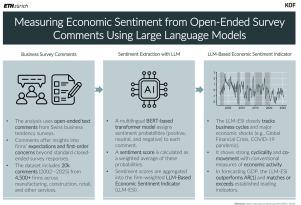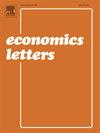使用大型语言模型从开放式调查评论中衡量经济情绪
IF 1.8
4区 经济学
Q2 ECONOMICS
引用次数: 0
摘要
本文通过将大型语言模型应用于瑞士商业趋势调查的开放式回应,开发了一种新的经济情绪指标(LLM-ESI)。使用基于bert的转换模型,它从自由文本调查评论中提取公司层面的情绪,并将其汇总为宏观经济状况的高频指标。LLM-ESI密切跟踪商业周期,在临近预测GDP方面的表现与传统基准相当,甚至更好。这些结果突出了大型语言模型和开放式调查响应的潜力,可以为实时经济分析提供及时而微妙的信号。本文章由计算机程序翻译,如有差异,请以英文原文为准。

Measuring economic sentiment from open-ended survey comments using large language models
This article develops a novel economic sentiment indicator (LLM-ESI) by applying large language models to open-ended responses from Swiss business tendency surveys. Using a BERT-based transformer model, it extracts firm-level sentiment from free-text survey comments and aggregates it into a high-frequency indicator of macroeconomic conditions. The LLM-ESI closely tracks the business cycle and performs on par with, or better than, traditional benchmarks in nowcasting GDP. These results highlight the potential of large language models and open-ended survey responses to deliver timely and nuanced signals for real-time economic analysis.
求助全文
通过发布文献求助,成功后即可免费获取论文全文。
去求助
来源期刊

Economics Letters
ECONOMICS-
CiteScore
3.20
自引率
5.00%
发文量
348
审稿时长
30 days
期刊介绍:
Many economists today are concerned by the proliferation of journals and the concomitant labyrinth of research to be conquered in order to reach the specific information they require. To combat this tendency, Economics Letters has been conceived and designed outside the realm of the traditional economics journal. As a Letters Journal, it consists of concise communications (letters) that provide a means of rapid and efficient dissemination of new results, models and methods in all fields of economic research.
 求助内容:
求助内容: 应助结果提醒方式:
应助结果提醒方式:


